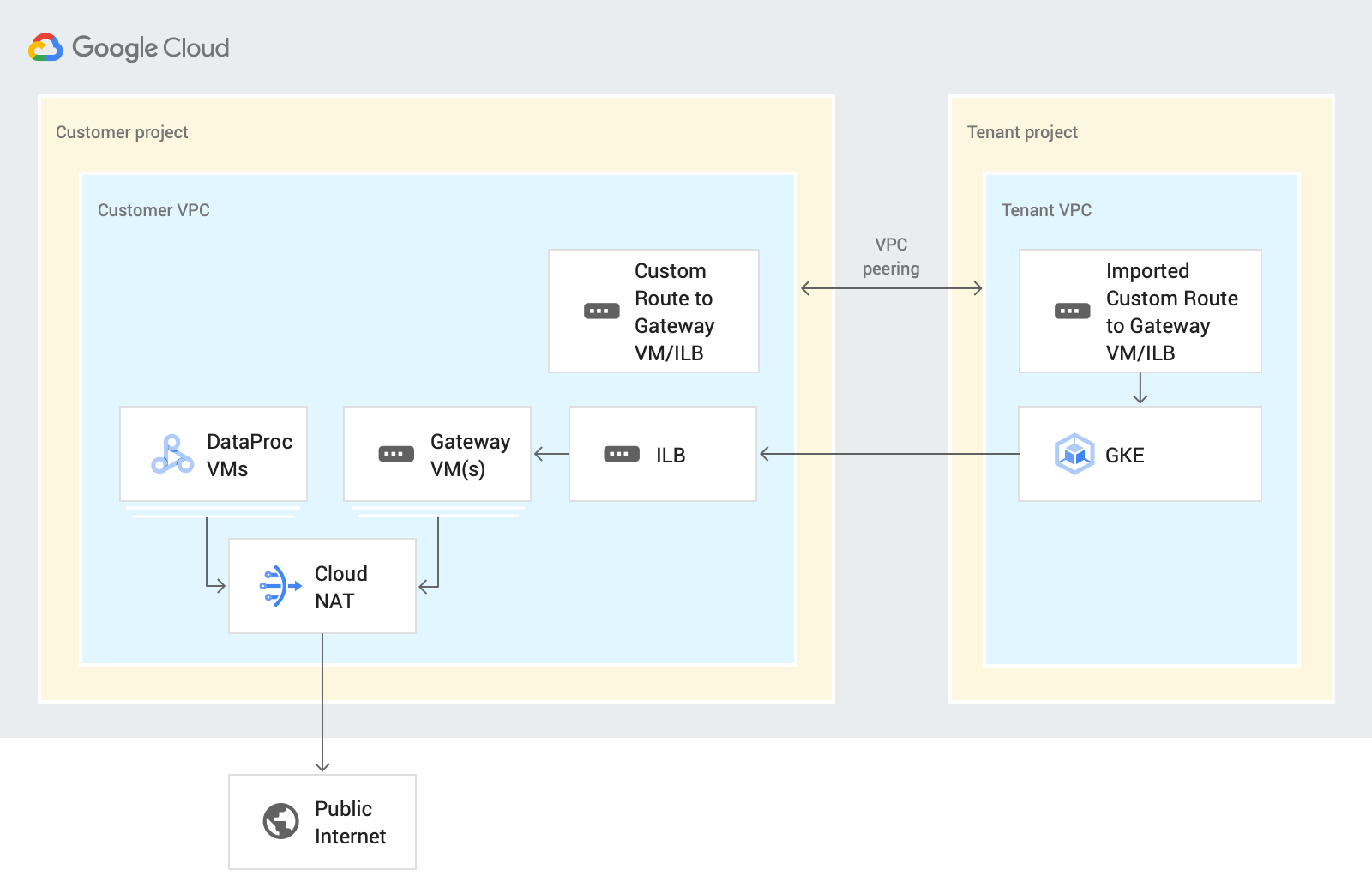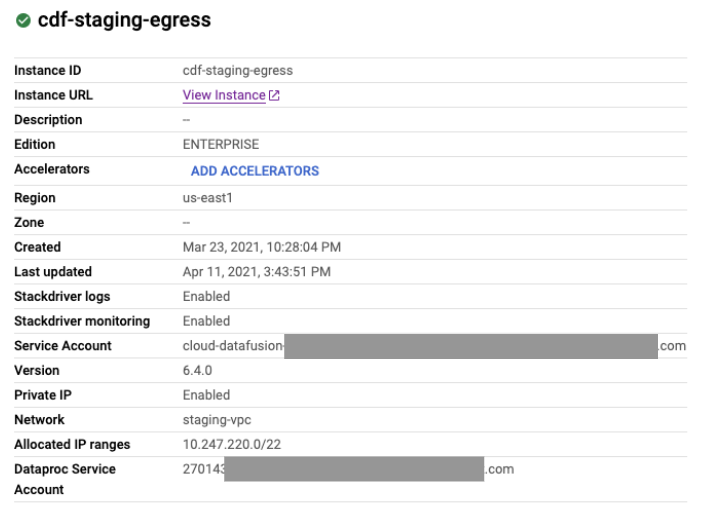This page describes how to connect to software-as-a-service (SaaS) applications like Salesforce, and third-party cloud services like Amazon S3, from a private Cloud Data Fusion instance when you develop a pipeline.
Throughout this guide, the terms egress and egress control are used:
Egress refers to the network traffic exiting Google Cloud over the public internet. Usually, egress happens when you create a pipeline that reads from or writes to a SaaS service like Salesforce, or a public cloud service like Amazon S3.
Egress control defines guardrails for egress traffic using a proxy VM, that allows egress traffic to a set of preconfigured domains to succeed, and all others to fail. It enables a higher security perimeter for egress traffic, and can prevent unwanted egress from a private instance.
The following system architecture diagram shows how a private Cloud Data Fusion instance connects with the public internet when you develop a pipeline:

When you design your pipeline in this scenario, Cloud Data Fusion routes egress traffic through your customer project in Cloud Data Fusion Preview or Wrangler. This process uses the following resources:
A custom VPC network route: A custom VPC network routes traffic through an imported custom route to gateway VMs, which export to a tenant project VPC using VPC peering.
A gateway VM: A gateway VM routes egress traffic out of Google Cloud from the Cloud Data Fusion tenant project to a SaaS or third-party cloud over the public internet. You manage this VM in your customer project. You can configure it in a High-Availability (HA) environment using an Internal Load Balancer (ILB). It's recommended that you reuse the VM for multiple private Cloud Data Fusion instances within the same VPC.
For information about setting up egress control in your design and execution environments, see Control egress in a private instance.
Before you begin
You can connect to a public source from a private instance in Cloud Data Fusion versions 6.4 or later. To use one of those versions, you can create a new private Cloud Data Fusion instance or upgrade an existing instance to 6.4.0.
When you create a VPC network peering connection for your instance, select Export routes.
Set up internet connectivity
The following steps describe how to access an Amazon S3 bucket from a private Cloud Data Fusion instance in Wrangler. The same steps apply to accessing any data source over the public internet when you design a pipeline in Preview or Wrangler.
Only a single VM is used in this guide, but for mission-critical applications, we recommend that you create load balanced VMs. For more information, see Set up High Availability VM.
Create an NAT gateway
Create a Cloud NAT gateway in the same region and VPC network as your Cloud Data Fusion private instance.
Create a gateway VM instance and firewall rules
Console
Go to the VM instances page.
Click Create instance. It's recommended to use a VM with no external IP.
Use the same VPC that has network peering set up with the private Cloud Data Fusion instance. For more information about VPC network peering in this scenario, see Before you begin.
Enable IP forwarding for the instance in the same network as the Cloud Data Fusion instance.
In the Startup script field, enter the following script:
#! /bin/bash echo 1 > /proc/sys/net/ipv4/ip_forward iptables -t nat -A POSTROUTING -s 0.0.0.0/0 -j MASQUERADE echo net.ipv4.ip_forward=1 > /etc/sysctl.d/11-gce-network-security.conf iptables-saveFor more information, see Running startup scripts.
To get the allocated IP range for the Cloud Data Fusion instance, go to the Cloud Data Fusion Instance details page.

gcloud
To create the gateway VM and firewall rules, run the following script in the Google Cloud CLI:
export CDF_PROJECT=CDF_PROJECT export GATEWAY_VM=GATEWAY_VM_NAME export ZONE=VM_ZONE export SUBNET=SUBNET export VPC_NETWORK=VPC_NETWORK export COMPUTE_ENGINE_SA=COMPUTE_ENGINE_SA gcloud beta compute --project=$CDF_PROJECT instances create $GATEWAY_VM --zone=$ZONE --machine-type=e2-medium --subnet=$SUBNET --network-tier=PREMIUM --metadata=startup-script=\#\!\ /bin/bash$'\n'echo\ 1\ \>\ /proc/sys/net/ipv4/ip_forward$'\n'iptables\ -t\ nat\ -A\ POSTROUTING\ -s\ 0.0.0.0/0\ -j\ MASQUERADE$'\n'echo\ net.ipv4.ip_forward=1\ \>\ /etc/sysctl.d/11-gce-network-security.conf$'\n'iptables-save --can-ip-forward --no-address --maintenance-policy=MIGRATE --service-account=$COMPUTE_ENGINE_SA --scopes=https://www.googleapis.com/auth/devstorage.read_only,https://www.googleapis.com/auth/logging.write,https://www.googleapis.com/auth/monitoring.write,https://www.googleapis.com/auth/servicecontrol,https://www.googleapis.com/auth/service.management.readonly,https://www.googleapis.com/auth/trace.append --tags=http-server,https-server --image=debian-10-buster-v20210316 --image-project=debian-cloud --boot-disk-size=10GB --boot-disk-type=pd-balanced --boot-disk-device-name=$GATEWAY_VM --no-shielded-secure-boot --shielded-vtpm --shielded-integrity-monitoring --reservation-affinity=any gcloud compute --project=$CDF_PROJECT firewall-rules create egress-allow-http --direction=INGRESS --priority=1000 --network=$VPC_NETWORK --action=ALLOW --rules=tcp:80 --source-ranges=CDF_IP_RANGE --target-tags=http-server gcloud compute --project=$CDF_PROJECT firewall-rules create egress-allow-https --direction=INGRESS --priority=1000 --network=$VPC_NETWORK --action=ALLOW --rules=tcp:443 --source-ranges=CDF_IP_RANGE --target-tags=https-server
Replace the following:
- CDF_PROJECT: the customizable unique identifier for your project
- GATEWAY_VM: the name of the VM you want to configure
- ZONE: the zone of your VM
- SUBNET: the subnet
- VPC_NETWORK: the name of your VM
- COMPUTE_ENGINE_SA: the name of your Compute Engine service account
- CDF_IP_RANGE: the IP range that's allocated to the Cloud Data Fusion instance
Using a shared VPC
If you use a shared VPC to connect your private Cloud Data Fusion instance to sources on the public internet, create a gateway VM in the host project where VPC network peering is set up with the tenant project.
Create a custom route
Create a custom route to connect to the gateway VM instance that you created.
Console
To create your route in the Google Cloud console, see Adding a static route.
When you configure the route:
- Set the Priority to greater than or equal to
1001. Set the destination to the IP range that's allocated to the Cloud Data Fusion instance. - Use the same project and VPC as the private Cloud Data Fusion instance.
- Be sure that your VPC network peering configuration allows exporting routes, so that the Cloud Data Fusion tenant project VPC imports this custom route through VPC network peering.
gcloud
To create your route in gcloud CLI:
export ROUTE=ROUTE gcloud beta compute routes create $ROUTE --project=$CDF_PROJECT \ --network=$VPC_NETWORK --priority=1001 \ --destination-range=0.0.0.0/0 \ --next-hop-instance=$GATEWAY_VM \ --next-hop-instance-zone=$ZONE
Replace the following:
- ROUTE: the name of the custom route.
Verify your setup
After performing the previous steps, verify that you can access S3 bucket services (or other SaaS or public cloud service) in Preview and Wrangler.
Set up a highly available Gateway
Recommended: For mission-critical applications, we recommend that you create load balanced VMs.
Create firewall rules for health checks
Create firewall rules to allow:
- Port 80 (HTTP) and port 443 (HTTPS) from all source ranges.
TCP, UDP, and ICMP traffic from health check prober IP addresses. For example:
130.211.0.0/22,35.191.0.0/16.
Console
Create Firewall rules to allow ports from all source ranges and firewall
rules to allow TCP, UDP, and ICMP traffic from health check prober IP
addresses such as 130.211.0.0/22,35.191.0.0/16.
gcloud
Create a firewall rule for health checks:
export CDF_PROJECT=PROJECT_ID export VPC_NETWORK=VPC_NETWORK gcloud compute --project=$CDF_PROJECT firewall-rules create vpc-allow-http \ --direction=INGRESS --priority=1000 \ --network=$VPC_NETWORK \ --action=ALLOW --rules=tcp:80 \ --source-ranges=CDF_IP_RANGE \ --target-tags=http-server gcloud compute --project=$CDF_PROJECT firewall-rules create vpc-allow-https \ --direction=INGRESS --priority=1000 --network=$VPC_NETWORK \ --action=ALLOW --rules=tcp:443 --source-ranges=CDF_IP_RANGE \ --target-tags=https-server gcloud compute --project=$CDF_PROJECT firewall-rules create allow-health-checks \ --network=$VPC_NETWORK \ --action=allow --direction=ingress \ --target-tags=allow-health-checks \ --source-ranges=130.211.0.0/22,35.191.0.0/16 \ --rules=tcp,udp,icmp
Replace the following:
- PROJECT_ID: the customizable unique identifier for your project.
- VPC_NETWORK: the name of your VPC network.
- CDF_IP_RANGE: the IP address range allocated to Cloud Data Fusion.
Create gateway VM instance template
Console
When you create an instance template in the console:
- Create it in the same VPC as the Cloud Data Fusion instance.
- Recommended: Use a VM with a private IP address.
- Enable HTTP/HTTPS ports.
- Enable IP forwarding
In the Startup script field, enter the following script:
#! /bin/bash echo 1 > /proc/sys/net/ipv4/ip_forward iptables -t nat -A POSTROUTING -s 0.0.0.0/0 -j MASQUERADE echo net.ipv4.ip_forward=1 > /etc/sysctl.d/11-gce-network-security.conf iptables-saveFor more information, see Running startup scripts.
To get the allocated IP range for the Cloud Data Fusion instance, go to the Cloud Data Fusion Instance details page.
gcloud
Create an instance template:
export TEMPLATE_NAME=TEMPLATE_NAME export REGION=REGION export SUBNET=SUBNET export SERVICE_ACCOUNT=SERVICE_ACCOUNT gcloud beta compute --project=$CDF_PROJECT instance-templates create $TEMPLATE_NAME \ --machine-type=e2-medium \ --subnet=projects/$CDF_PROJECT/regions/$REGION/subnetworks/$SUBNET \ --network-tier=PREMIUM --metadata=startup-script=sudo\ bash\ -c\ \"echo\ 1\ \>\ /proc/sys/net/ipv4/ip_forward\"$'\n'sudo\ iptables\ -t\ nat\ -A\ POSTROUTING\ -s\ 0.0.0.0/0\ -j\ MASQUERADE$'\n'sudo\ bash\ -c\ \"echo\ net.ipv4.ip_forward=1\ \>\ /etc/sysctl.d/11-gce-network-security.conf\"$'\n'sudo\ iptables-save \ --can-ip-forward --no-address --maintenance-policy=MIGRATE \ --service-account=$SERVICE_ACCOUNT \ --scopes=https://www.googleapis.com/auth/devstorage.read_only,https://www.googleapis.com/auth/logging.write,https://www.googleapis.com/auth/monitoring.write,https://www.googleapis.com/auth/servicecontrol,https://www.googleapis.com/auth/service.management.readonly,https://www.googleapis.com/auth/trace.append \ --region=$REGION --tags=http-server,https-server,allow-health-checks \ --image=debian-10-buster-v20210316 \ --image-project=debian-cloud --boot-disk-size=10GB \ --boot-disk-type=pd-balanced \ --boot-disk-device-name=$TEMPLATE_NAME \ --no-shielded-secure-boot --no-shielded-vtpm \ --no-shielded-integrity-monitoring \ --reservation-affinity=any
Create a health check
No service runs on this gateway VM instance, so you can use port 22 for your
health check.
Console
gcloud
Create a health check:
export HEATH_CHECK=HEALTH_CHECK_NAME gcloud beta compute health-checks create tcp $HEATH_CHECK --project=$CDF_PROJECT \ --port=22 --proxy-header=NONE --no-enable-logging \ --check-interval=5 --timeout=5 \ --unhealthy-threshold=2 --healthy-threshold=2
Create an instance group
Using the health check created in the previous step, create an instance group:
Console
gcloud
Create an instance group:
export INSTANCE_GROUP=INSTANCE_GROUP gcloud beta compute --project=$CDF_PROJECT instance-groups managed create $INSTANCE_GROUP \ --base-instance-name=$INSTANCE_GROUP \ --template=$TEMPLATE_NAME --size=1 --zone=$ZONE \ --health-check=test --initial-delay=300 gcloud beta compute --project "$CDF_PROJECT" instance-groups managed set-autoscaling "$INSTANCE_GROUP" \ --zone "$ZONE" --cool-down-period "60" \ --max-num-replicas "10" --min-num-replicas "1" \ --target-cpu-utilization "0.6" --mode "on"
Create a load balancer
Create TCP load balancer (ILB) from the instance group created in the previous step.
Add the custom route to the load balancer
Add the custom route to the Internal Load Balancer (ILB) in the same VPC as the Cloud Data Fusion instance.
Console
Go to the VPC network page.
In the Routes tab, click Create Route.

gcloud
Add the custom route to the internal load balancer:
export ROUTE=ROUTE_NAME export ILB_FRONTEND=<ip_of_ilb_frontend> gcloud beta compute routes create $ROUTE --project=$CDF_PROJECT \ --network=$VPC_NETWORK --priority=1001 \ --destination-range=0.0.0.0/0 \ --next-hop-ilb=$ILB_FRONTEND \ --next-hop-ilb-region=$REGION
Troubleshooting
Getting Connection Timeout errors in Preview or Wrangler
When setting up egress controls, you might get a Connection Timeout error.
To fix the issue, check that the following settings are in place:
- The VPC network peering between tenant project and customer project is present.
- The VPC network peering has Export routes enabled.
- The custom route to gateway VM or ILB is not missing.
- The firewall rules that allow
HTTPandHTTPStraffic are not missing.
Instance group health checks are not successful
Check that firewall rules
to allow TCP, UDP, and ICMP traffic from the
130.211.0.0/22,35.191.0.0/16 source range are present.
Pipeline fails while executing in Dataproc
To access public internet at execution time, enable Cloud NAT in the same region and network as the Dataproc cluster.
What's next
- Learn how to control egress in a private Cloud Data Fusion instance to only a specific set of domains.
- Learn more about Networking in Cloud Data Fusion.
